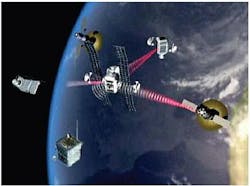DARPA seeks to develop small reconnaissance satellites that are cheaper to build than UAVs
ARLINGTON, Va., 11 May 2012. Scientists at the U.S. Defense Advanced Research Projects Agency (DARPA) in Arlington, Va., want to make relevant battlefield imagery available to front-line warfighters in real time using constellations of temporary and inexpensive orbiting satellites that are launched quickly enough to support fast-moving military operations.
The DARPA Tactical Technology Office (TTO) released a broad-agency announcement (DARPA-BAA-12-35) Wednesday for the Space Enabled Effects for Military Engagements (SeeMe) program that aims to provide useful on-demand imagery directly to the lowest-echelon warfighter in the field from small low-cost satellites.
The SeeMe satellites would help clear away the fog of war by filling gaps in battlefield situational awareness before, during, and after military engagements, DARPA officials say. Companies interested in participating have until 29 June 2012 to submit proposals.
The SeeMe program would provide reliable persistent-surveillance data to front-line forces using small, short-lived, very-low-cost satellites operating at low altitudes that are networked to fielded military communications systems and handheld devices. Satellites should cost no more than $500,000 each, not counting launch and ground-support operations.
DARPA experts say they expect to award several initial SeeMe contracts, and the total cost of the program's first phase will be about $45 million.
The SeeMe short-duration satellite constellations would compensate for today's weaknesses in gathering situational-awareness data that today does not provide the lowest-echelon warfighters with on-demand satellite imagery due to the unavailability of satellite overflight opportunities, lack of information distribution channels, priority conflicts, and classification restrictions.
At the same time, terrorists and other enemy forces have access to commercial imagery information that gives them an advantage. The SeeMe program would give small U.S. squads and fire-teams reliable information in remote and beyond-line-of-sight conditions, DARPA officials say.
Rather than using expensive high-orbit reconnaissance satellites that are tasked remotely and their products analyzed through a centralized organization, the SeeMe program would use short-lived low-cost satellites would provide large global coverage at lower cost than a set of unmanned aerial vehicles (UAVs) flying simultaneously over several theaters per day, DARPA officials say.
SeeMe satellites would be designed based on cost, rather than on performance, and would seek to revolutionize the existing satellite-development model to cut costs to a fraction of manned or unmanned aircraft -- primarily using commercial off-the-shelf (COTS) components.
SeeMe satellites also would use non-traditional RF and optical apertures and imagery processing techniques, as well as innovative manufacturing and rapid launch systems to match the speed of military operations.
The SeeMe program is coordinating with the DARPA Airborne Launch Assist Space Access (ALASA) program, which aims to drive down launch costs with revolutionary technologies and operations approaches to create affordable launch capability for small satellites to low-altitude orbits.
The combined SeeMe and ALASA programs will culminate in an on-orbit demonstration in 2014 or 2015 of a constellation of 24 SeeMe satellites operating in low orbits between 125 and 185 miles above the Earth.
The program seeks to deliver a constellation of small reconnaissance satellites within 90 days order at a cost of about $12 million -- a fraction of the cost of an existing UAV. SeeMe satellites would provide persistent coverage of any point on the Earth with no coverage gaps greater than 90 minutes, and would last for at least 45 days.
The preliminary phase of the SeeMe program is to last for 14 months, while the second phase of the program would last for 15 months and demonstrate a production run of at least six satellites. The third phase would last a year and produce a constellation of 24 satellites.
For questions or concerns, contact the SeeMe program by e-mail at [email protected], or by fax at 703-516- 8725, Attention: DARPA-BAA-12-35. Proposals may not be submitted by fax or e-mail. The SeeMe program manager is David Barnhart.
Those interested should send proposals in writing and on CDROM by post no later than 29 June 2012 to DARPA/TTO Attn: DARPA-BAA-12-35 30, 675 North Randolph St., Arlington, Va., 22203-2114.
More information is online at https://www.fbo.gov/spg/ODA/DARPA/CMO/DARPA-BAA-12-35/listing.html.
